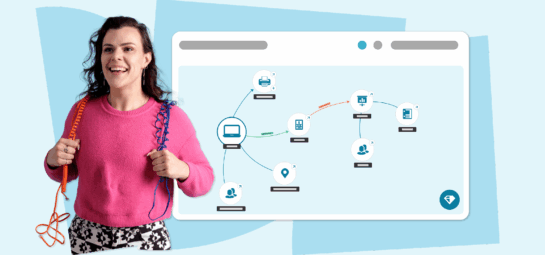7 steps for a smooth ITSM implementation for your organization

Aligning your IT processes with your business goals through IT Service Management (ITSM) has many benefits for your organization, from improved efficiency to better customer service and lower costs. This blog offers practical, actionable steps to help you successfully implement ITSM in seven steps, while showcasing how ITSM software can streamline and support the ITSM implementation process.
What is ITSM implementation?
Implementing ITSM means rolling out IT service management practices across your company in an organized way. It helps by automating tasks and making sure IT activities line up with what the business needs. This boosts productivity, reduces service interruptions, and improves the quality of service you deliver. Essentially, ITSM turns your IT department from just a support role into a key player that drives business success.
Step-by-step guide for ITSM implementation
Introducing ITSM to your organization doesn’t happen overnight. It takes time, capacity and money — an investment you’ll want to see reflected in tangible improvements and results. These are the seven steps of a successful ITSM implementation:
1: Establish a solid foundation for your ITSM implementation
Make sure to build your ITSM implementation on rock-solid foundations. Start by linking your service desk Key Performance Indicators (KPIs) to your organizational goals. Make the benefits of ITSM directly measurable and use them as input to craft a compelling ITSM business case. You can use this business case to rally support from key stakeholders (those who will impact or be impacted by the ITSM implementation). Remember, a satisfied team leads to satisfied end-users, so prioritize employee satisfaction from the get-go.
2: Select the right technology and tools for your ITSM implementation
Choosing the right ITSM software is key to making your ITSM implementation successful. But the ITSM software landscape is complex and offers a lot of choice of different vendors with distinctive features and pricing models, which doesn't make selecting an ITSM tool easier. Be sure to include these elements in your consideration:
- functionality and features that contribute to achieving your objectives;
- flexibility, adaptability and scalability of the software so that it can grow with your changing requirements and needs;
- good integration possibilities with other systems used in your organization;
- security functions and capabilities of the ITSM tool. Consider access controls, data encryption, regulatory compliance (such as GDPR, HIPAA, etc.) and other security measures.
As well as looking at features, it’s worth considering the personal touch when looking at software vendors. In many cases, people still prefer to interact with real people, especially when implementing new software. Having a good click with the software supplier is a necessity, not a luxury. Personal contact for questions, tips and training can make all the difference.
Discover what TOPdesk's ITSM software can do for your IT department.
3: Create a realistic and comprehensive ITSM implementation plan
Drawing up a detailed plan is the next step in a well-thought-out ITSM implementation process. At the very least, your plan should include:
- your objective and scope (determining processes and functionality);
- the composition of your project organization;
- assigned responsibilities;
- any important milestones and deadlines;
- a plan B for plausible risks.
Make sure your plan is realistic by considering available resources, the project's complexity and the likelihood of running into obstacles along the way.
4: Get started with your ITSM implementation
Once you have everything in place, it's time to get started on the ITSM implementation itself. Focus on the winning trio: people, processes, and technology. Give each group the attention it needs in each phase of the ITSM implementation.
Your ITSM software supplier will help you install and configure the application. They're also your go-to people for setting up access management. Once the software is ready and important integrations have been realized, you can start migrating data.
5: Address any challenges effectively
It's a cliché, but it’s true: people don’t like change. Especially when it comes to processes and tools they work with every day. Keep listening carefully to those involved and make sure to do something with their feedback. This is how you turn natural resistance into enthusiasm.
Technology comes with endless possibilities. But it doesn't always immediately do what you want it to. Make sure you have enough space in your schedule and sufficient backups to help you manage (temporary) technical problems.
6: Measure and celebrate success
A successful ITSM implementation requires a well-thought-out plan and more than a little determination. It's important to keep those involved enthusiastic and motivated. One way of doing this is to celebrate successes.
Have you met an important deadline, are you getting enthusiastic feedback on the new ITSM software, or is the number of outstanding IT tickets clearly decreasing? These are all reasons to celebrate. And this doesn’t have to be with cake and balloons, but can also be done with a heartfelt, public compliment.
Besides celebrating successes, it’s important to reflect on things that didn't go as well and what you learned from them. This way, you create a transparent culture where people dare to make mistakes and think outside of the box.
7: Continuously monitor and optimize
During and after the initial ITSM implementation and the associated supporting software, you start to see an impact on your organization. For example, based on the KPIs you determined at the start.
ITSM isn't something you implement once and never touch again. Like the supporting technology, it will change. Make sure you have easy-to-access feedback mechanisms, so end users and agents can point out areas for improvement.
Best practices for a successful ITSM implementation
You can read up on theory all you like, but most ITSM knowledge comes from practice. We’ve gathered some learnings from real-life ITSM implementations gone by to help you prepare for your own ITSM implementation journey.
Consider these best practices for a successful ITSM implementation:
Go for a gradual ITSM implementation
Don't implement ITSM processes with a ‘big bang’ but break them down into manageable steps. Start with core processes and gradually expand to more complex processes. This approach allows for easier adjustments and reduces the risk of disruptions.
Stay flexible and adapt where necessary
Nothing stays the same, even during ITSM implementations. Make sure your ITSM strategy can adapt as circumstances and needs change. Take user feedback into account and align processes and systems with the needs of the organization.
Keep improving continuously
ITSM is a continuous improvement process. Work on creating a culture of continuous improvement where you encourage employees to give feedback and make suggestions to make your ITSM implementation and processes a success.
By implementing these best practices, you can ensure your ITSM implementation and journey is smooth and successful, leading to a more agile and resilient organization.
Common pitfalls of ITSM implementations to avoid
When implementing ITSM, steering clear of the following common pitfalls can pave the way for a smoother journey:
Setting goals that are too ambitious – this can lead to unrealistic expectations and disappointment if you don’t meet your goals in time.
Poor planning and insufficient preparation – these often lead to delays, budget overruns and quality problems during implementation (and afterwards).
Too much focus on technology – focusing only on the technical aspects of ITSM and paying too little attention to people can slow down your end users’ adoption of your new processes and systems.
By keeping these pitfalls in mind, you can create a well-rounded, effective ITSM implementation that benefits both your technology infrastructure and the people who drive it.
ITSM implementation in practice
Customized solution or standard ITSM tool? This is the question most organizations are faced with at the start of an ITSM implementation. For the University of Memphis, the answer was clear. Having struggled to power their service desk using multiple, cobbled together tools, the simplicity of a standard solution was a breath of fresh air. Curious about their ITSM journey? Read the full University of Memphis story here.
For Canadian retail company Roots, getting buy-in from their 400+ end users proved to be no easy feat. Luckily, with the help of TOPdesk, they were able to demonstrate the benefits of using an ITSM tool to their customers. Want to know how they did it? You can read the Roots ITSM story here.
Key trends influencing ITSM implementations
Key trends are shaping the future of ITSM implementations, and it's crucial to stay ahead of the curve.
- More and more organizations are moving to cloud-based ITSM solutions because of the benefits in terms of scalability, flexibility and cost savings.
- Service automation and AI are expected to play a bigger role in ITSM as technologies evolve and organizations strive for efficiency and better user experiences.
- With the growing amount of data available, data analytics and BI are becoming more important - including for improving ITSM processes and making data-driven decisions in this context.
- As more and more organizations start to use hybrid IT environments, there's a growing need for ITSM solutions that seamlessly integrate local and cloud-based systems.
Want to stay on top of ITSM trends? By working closely with your ITSM software vendor, you can identify opportunities faster and can test innovative solutions first.
How TOPdesk facilitates ITSM implementation
TOPdesk’s ITSM software simplifies every part of your IT service management journey, from your initial ITSM implementation to making continuous improvements. We offer a single ITSM software platform for all your requests, assets and workflows that makes your IT services consistently great. Discover what TOPdesk's ITSM software can do for your IT department.
FAQs about ITSM implementation
What is ITSM and why is it important?
IT Service Management (ITSM) refers to the processes and technology involved in managing an organization's IT services. It’s crucial for improving service delivery, aligning IT activities with business objectives, and enhancing overall efficiency.
How long does an ITSM implementation typically take?
The time it takes to implement ITSM can vary based on the size of the organization, the complexity of existing IT systems, and the scope of the implementation. It can take anywhere from a few months to over a year for a full implementation.
Can small businesses benefit from an ITSM implementation?
Absolutely! ITSM is not just for large organizations. Small businesses can also gain significant efficiencies, improve service quality, and better align IT operations with business goals through ITSM.
What to take away from this blog
Implementing ITSM can make a big difference for your organization by improving your IT services and aligning them with your business goals. This blog shared the key steps for a smooth ITSM implementation, helpful tips to follow, and mistakes to watch out for. Ready to get started? Download our ITSM buyer’s guide or sign up for a demo today, and see how you can transform your IT operations.
Get the low-down on modern ITSM tools
On the hunt for an ITSM tool that will support your ITSM implementation? Check out our ITSM Buyer’s Guide for everything you need to find your perfect ITSM solution.
Inspire others, share this blog



